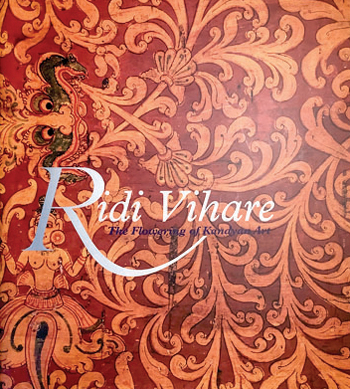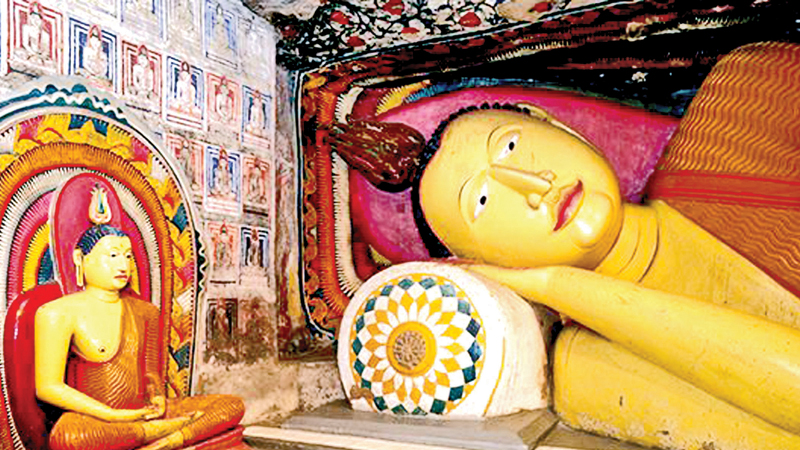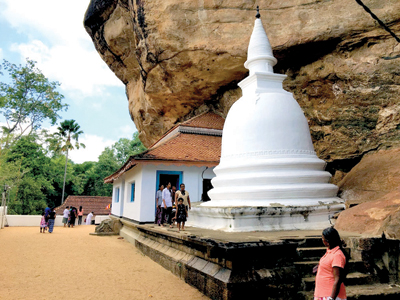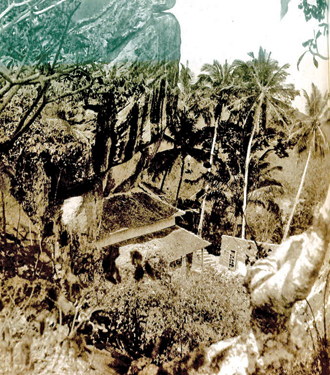Ridi Vihare: The Flowering of Kandyan Art-by Uditha Devapriya
Dr Sinha Raja-Tammita Delgoda’s Ridi Vihare: The Flowering of Kandyan Art Stamford Lake Publications, 2006,
This is a fascinating study of one of the more fascinating Buddhist temples of Sri Lanka, authored by one of our foremost historians. The Ridi Vihare or “Silver Temple” traces its history to the second century BC. It occupied a prominent place until the 14th century AD, when it disappeared from view. 300 years later, during the time of the Nayakkar kings of Kandy, it regained that position. What Dr SinhaRaja Tammita-Delgoda attempts in his book is to explore its history and its art, viewing them not in isolation but in unison. The result is a superb work of scholarship, at once edifying and accessible.
The history of Ridi Vihare begins with “the greatest king of Anuradhapura”, Dutugemunu, in the second century BC. The Mahavamsa records Dutugemunu as the first of the Sinhalese kings who brought the entire country together. Having achieved this task, he embarked on the construction of stupas, the last of which, the Mahathupa, became a huge undertaking. It was in reply to his prayer that money be found for the Mahathupa that silver was found at a cave called Ambattakola in Kurunegala. As a token of gratitude, Dutugemunu had a temple built by a jackfruit tree near that cave. It is here that the Varaka Velandhu Vihare, the oldest and most important establishment at Ridi Vihare, stands today.
As with all such institutions, the temple amply reflected its times. Thus by the time of the Polonnaruwa kingdom, South Indian influences began making their way to the Ridi Vihare. We are told that a Hindu devale was constructed within the courtyard somewhere after the 12th century. Though popular writers portray this as a period of decay and destruction, it was also a period of cultural fusion. Ridi Vihare did not escape such influences, in spite of the impoverished conditions of these years. It remained a centrepiece of the kingdom into the 14th century, although once the capital of the Sinhalese polity shifted from Wayamba to Kotte to Kandy rata it fell into much decay, decline, and disrepair.
Kandyan kings
The next chapter of Ridi Vihare unfolds at the time of the Kandyan kings, specifically the Nayakkars and particularly the reign of the second of them, Kirti Sri Rajasinghe. An ardent, passionate patron of Buddhism, Rajasinghe oversaw a period of renaissance marked by the resumption of the ordination of bhikkhus, a practice that had fallen into neglect for centuries. We are told of the political conditions prevalent at the time, including the rebellions against them aided by the leading revivalist of his time, Valivita Sri Saranankara.
In the course of his reign Kirti Sri Rajasinghe brought Buddhist temples under the sway of the two monastic orders, Malwatte and Asgiriya. This decision had much to do with the personality of the king. As an outsider, Rajasinghe had to show himself as the heir to his Sinhalese predecessors. Though Leslie Gunawardana and Gananath Obeyesekere have suggested that opposition to Nayakkar rule was not as prevalent as is often made out to be, there definitely was opposition, and it was considerable.
The king’s motives were under scrutiny by the radala aristocracy and clergy, and he needed to prove himself worthy in their eyes. To let go and belittle their concerns was to invite disenchantment, even rebellion. This the Nayakkars understood well.
It was against that backdrop that Kirti Sri Rajasinghe pursued a policy of detente and then confrontation with Dutch governors, while sponsoring efforts at purifying the sangha. Spilling over to the religious institutions of his realm, these efforts transformed Ridi Vihare into a leading centre of learning and study, in particular under Tibbotuwawe Sri Siddhartha Buddharakkitha, the closest disciple of Velivita Sri Saranankara.
International relations
Largely due to his upcountry ancestry, Dr Tammita-Delgoda is at his best in these chapters, when he is charting the social and artistic history of the last Sinhalese kingdom. Having read and researched his sources well, he goes beyond them, conjecturing about the reputation Ridi Vihare would have enjoyed under Buddharakkitha. He takes pains to emphasise that though Kandy was at war with the Dutch, this did not preclude contact between officials and bhikkhus, a point that shows well in the Delft tiles at the Maha Vihare of Ridi Vihare. Long thought to be a gift from the Dutch Governor to the Vihare’s chief incumbent, these objects shed light on the nature of relations between Kandy and Holland.
From historicising Ridi Vihare, Dr Tammita-Delgoda goes on to deconstruct its topography, periodising its construction from the pre-Christian era to the 20th century. He then delves into the paintings and sculptures at the temple. With more than a connoisseur’s eye for the elegant and the sublime, he expresses much distaste for contemporary efforts at repairing the site, particularly the “hideous” restored vahalkada at its entrance. In exploring the inner courtyards and sanctums, he also tries to reconstruct life as it would have been back in the day, especially through archive images and illustrations.
There is clearly an art historian lurking beneath the historian, and in the chapters on the art and sculpture of Ridi Vihare Dr Tammita-Delgoda lets him out.
Not surprisingly, these make up some of the best forays into Kandyan art and architecture I have read. Colonial officials and scholars often painted Kandy as a period of cultural decay, a pitiful reflection of the classical art of Anuradhapura and Polonnaruwa.
Such generalisations were questioned by the likes of Dr Senake Bandaranayake and Siri Gunasinghe. Dr Tammita-Delgoda continues their line of critique, unearthing Kandyan art for what it is and not for what it is often imagined to be. Its aim, he notes, was to appeal to devotees, not conform to European rules of perspective and representation.
Final chapter
 Because of these insights, the sections on the paintings and sculptures of Ridi Vihare are the most edifying in the book. Even more edifying is the final chapter, a personal meditation on the nature of Sinhalese art. Dr Tammita-Delgoda provocatively calls it the “art of the poor people”, as it indeed was. Reflecting on Ananda Coomaraswamy’s Medieval Sinhalese Art, he contends that the world around these temples shaped their architecture, differentiating them from the much larger monuments of Anuradhapura and Polonnaruwa.
Because of these insights, the sections on the paintings and sculptures of Ridi Vihare are the most edifying in the book. Even more edifying is the final chapter, a personal meditation on the nature of Sinhalese art. Dr Tammita-Delgoda provocatively calls it the “art of the poor people”, as it indeed was. Reflecting on Ananda Coomaraswamy’s Medieval Sinhalese Art, he contends that the world around these temples shaped their architecture, differentiating them from the much larger monuments of Anuradhapura and Polonnaruwa.
Scholars may see that as a defect in Kandyan architecture, but it was a form shaped by the society around it and the privations imposed by colonialism.
Hemmed in from all sides, Kandyan temples could not aspire to the munificence of earlier periods. That they managed to attract devotion and patronage despite this is, in that sense, remarkable.
A book like this contains few flaws. Its chief limitation is its lack of focus on the material and economic conditions of Kandyan society, the contributions of the people to the construction of these edifices, and the point that such institutions were as much the work of kings and bhikkhus as of people. Dr. Tammita-Delgoda does identify the painters of Ridi Vihare and their backgrounds, but often he implies that kings, aristocrats, and monks were all that mattered in 18th century Kandy. What were the conjunctions of class and caste which produced these magnificent edifices? Clearly, there is space for more research.
Nevertheless, as a labour of love and a token of gratitude to the bhikkhus who tutored the author, Ridi Vihare: The Flowering of Kandyan Art remains a first-rate work. It shows us a pathway to the past. Seeing it one can only quote Ananda Coomaraswamy.
In the words of Blake,
When nations grow old,
The Arts grow cold,
And commerce settles on every tree.
In such a grim fashion has commerce settled in the East.
If we do not delve into our past, we are doomed to forget it. It is this point that Dr Tammita-Delgoda brings up, a point we would do well to acknowledge.
-The writer is an international relations analyst, independent researcher, and freelance columnist who can be reached at udakdev1@gmail.com.










